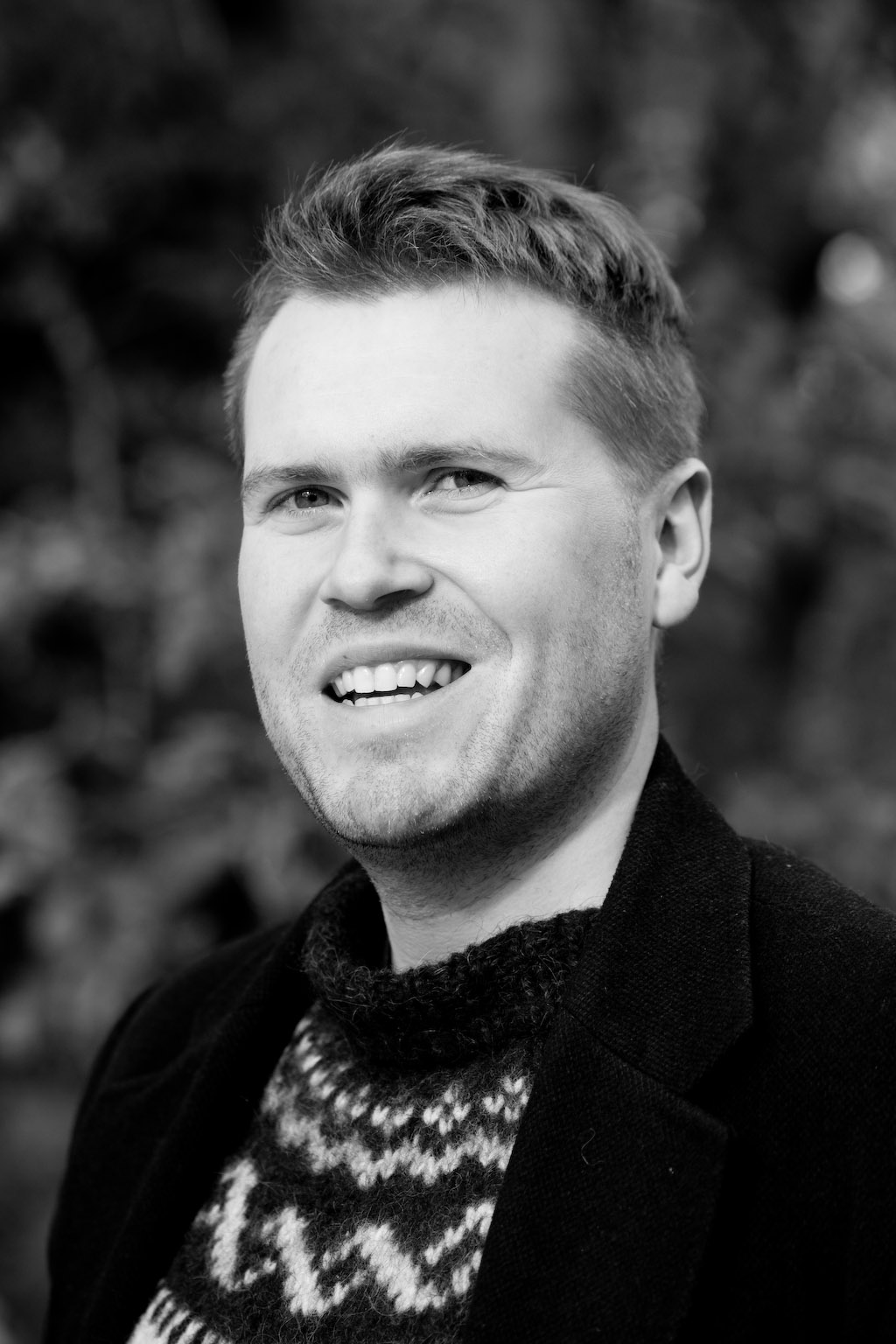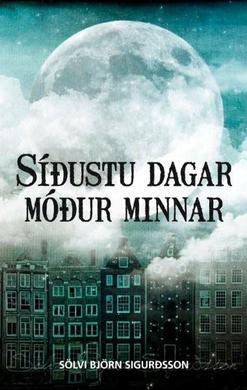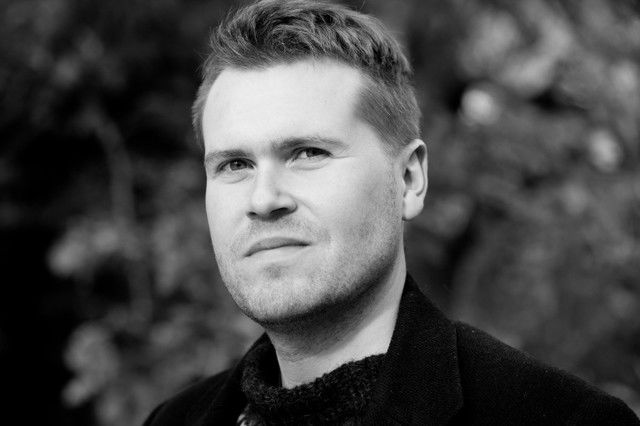Sölvi Björn Sigurðsson
“Anybody, anything can inspire you: a museum brochure, a shampoo bottle, even a TV show about an Englishman's armpit,” says author Sölvi Björn Sigurðsson, whose next novel will provide a fresh take on greed, heartbreak, domesticated pigs and much besides.

Sölvi Björn Sigurðsson is the author of three published novels, who also enjoys a strong reputation as a poet. His novelistic debut, Radío Selfoss / Radio Selfoss, an Icelandic family tale, came out in 2003. Before he turned to novels, he had published the poetry collections Ást og frelsi / Love and Freedom and Vökunætur Glátúnshundsins / Sleepless Nights of the Glátún Dog. The novel tells the story of an Icelandic family which moves from Denmark to the small Icelandic town of Selfoss during the mid-eighties. Critics hailed the book as a strong debut or, to quote critic Jón Yngvi Jóhannesson: “a beginner's work as beginner's works should be.”
Taking on the titans
Sigurðsson's next two works were a bit more unconventional, both in form and content. During an interview in Morgunblaðið, taking place shortly after the publication of Radíó Selfoss, he was asked whether his debut novel could have been delivered in an epic poem. “If so,” Sigurðsson answered, “it would have to be a very long epic poem, written in hexameter.”
This conversation may well have been the inspiration for his next work, Gleðileikurinn djöfullegi / The Diabolical Comedy – an ambitious epic poem about a young man's quest through the sordid underbelly of Reykjavík's night life. The work takes as its model Dante's epic cycle The Divine Comedy, in terms of structure, poetic form and plot. Most critics agreed that the book was one of the most daring, entertaining and innovative works of poetry written during the last few years: “A postmodern, recycled product of unusually high quality,” as Morgunblaðið critic Skafti Þ. Halldórsson put it. Gauti Kristmannsson, critic for the radio program Víðsjá, was enthralled: “Sigurðsson has managed to write an urban poem of Reykjavík, which is a pleasure to read. The poem isn't shy of presenting itself as verse – both in form and content – but it is also a smooth read for contemporary readers. At the same time, the famed Reykjavík night-life, with all its nonsense, gets a dressing-down, although no-one's wagging a finger.”
Sigurðsson's next book, Fljótandi heimur / Floating World, which came out in 2006, was another work of experimental recycling, in which Sigurðsson took on another literary titan: Haruki Murakami. The story is a mish-mash of genres – romance, thriller, science fiction – describing the relationship between a young Icelandic student from the countryside, and a mysterious model – the half-Japanese Saiko. In a typical Murakami fashion, the girl vanishes, propelling the protagonist into a whiskey-drenched and reality-warping search for her. Morgunblaðið critic Björn Þór Vilhjálmsson pointed out that this sort of work ran the risk of getting bogged down in the clichés of postmodern pastiche, but considered Sigurðsson to have “harnessed the spirit of Murakami to reinvigorate much of what has become cliché in postmodernism [...] The trick Sigurðsson uses to avoid the pitfalls of postmodern irony is sincerity – his relationship with Murakami is primarily founded on pleasure in the fact that the latter author exists at all.” Fréttablaðið critic Kristrún Heiða Hauksdóttir was also fascinated by the book, declaring it to be comprehensively though-out and high in impact: “An original and contemporary story, which grapples courageously with literature and modernity.”
 Life, death and binge-drinking
Life, death and binge-drinking
In his newest book, Síðustu dagar móður minnar / The Last Days of My Mother, Sigurðsson contemplates both the nature of death and joie de vivre. It recounts 37-year-old Hermann's relationship with his colorful mother, who is afflicted with cancer. The two of them set out on a hard-drinking, picaresque-like quest to Amsterdam, where the mother is meant to undergo therapy. Meanwhile, Hermann deals with a crisis of his own, having just broken up with his girlfriend of many years.
The trip prompts both mother and son to reevaluate life – its termination as well as the possibility of a fresh start, while also putting their relationship to the test. Although the work's themes are heavy, the critic Þórarinn B. Þórarinsson received it warmly: “A wonderful story, and extremely entertaining. The poet Sigurðsson is blossoming as a novelist.” Bergsteinn Sigurðsson of Fréttablaðið declared it the author's most polished work to date: “The style is robust and supple. Descriptions of characters and events are often priceless, and the conversations are a smooth-flowing pleasure [...] Síðustu dagar móður minnar is a darkly humorous work, but also very sad – a mortal struggle, where the joy of life wrestles with the fear of death, and often no way of knowing which one of the two is on top [...] A brilliantly written book; funny, melancholy and very beautiful.”
"Fear and Loathing in Amsterdam"
Sagenhaftes Island had a chat with Sölvi – about influences, literature and the near future:
Do you have any role models in literature?
Anybody and anything can inspire you, really: a museum brochure, a shampoo bottle, even a TV show about an Englishman's armpit. The bibliography of Fljótandi heimur lists an interview with Nicole Richie as a source, but I wouldn't compare her to Dostoyevsky. I appreciate the madness in books like The Brothers Karamazov but you can't really speak of being influenced by that sort of an author, he's just around. I started out being influenced by Þórbergur and Laxness. Looking at it that way, I suppose I made my way into Icelandic literature conventionally. But then new authors come along, different authors. Ultimately, I hope I'm not a copy of any of them, even if they touched me during a specific time period.
Síðustu dagar móður minnar, your latest work, raises big question about the way modern people deal with death – for example, the issue of assisted suicide. What made you tackle these sensitive themes?
That's a fine question, but I'm not sure how to answer. Maybe it's because the book was never supposed to be “heavy.” On the contrary, it was supposed to be light, and I think it is, even if the underlying themes are dramatic. I liked its title, it was one of the first things I decided on. The mother as a life-force – and that life-force confronting the end – seemed to me a good combination for a novel. Especially if I went about it unconventionally, and managed to represent mother and son as a twosome in the spirit of Holmes and Watson. There's a bit of “Fear and Loathing in Amsterdam”, a bit of The Odd Couple, in all their drinking and escapism.
After two experimental works, Síðustu dagar móður minnar finds you back in more conventional territory. Are you planning on staying there, or will you venture back into experimentation?
I was pretty young when I first tried my hand at writing, and I had the feeling that experimentation – with form, with narrative technique, the interplay between genres and even between my own writing with other authors – was a necessary part of the process of becoming a writer. The first novel I tried to write was about a man who hires a room at a small country hotel in order to complete a novel. His stay is uneventful, until he decides to take a break from writing to invite his friends to a party. While he's waiting for the guests, he ventures into unexplored passages in the hotel, where he runs into unexpected company: Raskolnikov, Don Quixote, along with other characters from literature. They lead him through one room after the other, which contain, among other things, chapters from the works of other authors. From there, the narrator is pushed into a sort of literary utopia, where Foucault fries meat-balls and Cervantes goes to jail. However, the narrator never finds his own guests – because, compared to what he has encountered, he himself has little to offer.
The idea was to write a novel which was about itself, about influence and dialog in the literary tradition, how each text is a “mosaic of quotations” and all the stuff that post-structuralism, T. S. Eliot, Kundera, and literature departments made you believe you had to keep in mind if you wanted to be a “real author”. But the story never really came to life and I gave it up. Then I went and wrote a completely different book, which was nevertheless an experiment of its own. I suppose Radíó Selfoss was an attempt at toning it down, writing a straight-forward story. A family story, a coming-of-age story, an entertaining story – whatever you want to call it. When it was over and done with, I went back to having ideas and did Gleðileikurinn djöfullegi and Fljótandi heimur, which I was a lot a happier with than the country-hotel story.
What now? What is your next story about, and in what vein will it be?
My publisher would probably say something along the lines of “The SIC report meets The Brothers Karamazov,” or “Like Nina Hagen had decided to write a 21st century Buddenbrooks.” All I can say is that the next novel will be longer than the previous ones, and that it's going to grapple with domesticated pigs in a fresh way, give a brief overview of the history of castration, search for a lost doctoral thesis on Icelandic literary history, study greed and heartbreak, delve into messed-up lives, investigate filial relationships, examine the relationship between parents and their children, provide insight into modern science and marriages, take on grief as an independent phenomenon – possibly hereditary ,or a sort of sublime version of a mistake or event which sets off tragedy – and if at all possible, it would be wonderful if it could shed some light on the reason everything went so fantastically wrong in Iceland.
